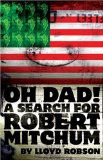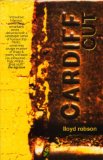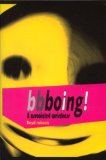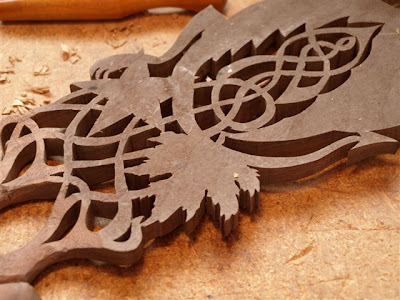Blogs
Lloyd Robson is a writer and broadcaster from Cardiff. As a poet he has performed and been published on five continents."Oh Dad! A Search For Robert Mitchum" ( reviewed below ) was first published by Parthian Books in 2008.

I dont normally read biographies because they always end the same way. But Lloyd Robson has solved this problem. His "biography" of Mitchum is as much about the author as it is about its subject. Fortunately for the reader both are fascinating characters.
For the hardcore Mitchum fan there is a wealth of biographical information. For instance we are told that at the time of his marriage ( aged 16 ) to Dorothy Spence:- " Mitchum was already a drinker - since he was eight - and Mary-Jane smoker; had already hobo'ed up and down the eastern seaboard; had already served time in jail. She was a good girl and younger. He was sixteen, she was fourteen - the age when according to Mitchum, 'A girl falls for derelicts'."
The book is peppered throughout with amusing and revealing quotes. For instance here is Mitchum discussing his 'range':- " I have two acting styles: with and without a horse." We are also told that:- "Famously when asked if he followed the Stanislavski method he replied, 'I follow the Smirnoff method'."
The plot of every movie, both major and minor, that Mitchum appeared in is referenced at some point in the narrative, usually in the context of some random encounter on the author's travels through the thirteen states that he visited in order to research this book. And what a strange and wonderful book it is. It works on so many levels. It is a meticulously researched account of the life, times and career of one of Hollywood's greatest actors but it is also a travelogue written from a perspective which should prove particularly interesting to members and readers of this site.
Anyone who has emigrated to these shores from the other side of the Atlantic will recall the many minor 'culture shocks' which they experienced when first they arrived and the many ways in which things seemed 'oddly familiar'. There are many instances of this in the book and it works well as a travelogue. Scattered throughout its 500 pages there are occasional reflections on Wales' image in modern America and on notions of 'Welshness' . On page 99 the author asks, with reference to an article in a Bridgeport newspaper which refers to a visit by David Lloyd George and describes him as 'a little Welshman':- " Still at least it proves the American press knew he was not English, and therefore they recognized there was a difference between being Welsh or English. So what's happened since to America's awareness of Wales? It struggles within the swamp of more assertive cultures."
Later in the book he encounters a Southerner who informs him that the "real" South is confined to Georgia and the Carolina's and that other parts of the former Confederacy have changed beyond all recognition. This leads to the following rather interesting reflection ( with apologies for the length of the quote ):- "So many Welsh people consider the major urban spread of Cardiff as not 'really' Welsh, nor the lowlands of Gwent, nor border towns like Chepstow and Monmouth, nor the north-east corner which comes under the influence of Merseyside. So what does this leave us with? Shrinkage. Geographically, culturally and emotionally. A different type of Wales - just as with a different type of the South - is viewed as a change too far. It's like saying, 'There is only one Wales, only one South - and you're not it, whatever you believe yourself to be.' And so we get smaller and weaker. It reeks of the modern age being judged as robbing now-urban areas of their rightful heritage. Well, change happens - we either accept and develop or get very, very lonely in an ever-reducing club, sat all on our lonesome in our chilly tai bach . And that's where we'll stay for as long as the question remains: are you as Welsh, are you as Southern as I am?"
The book is liberally spiced with accounts of bar room encounters and sexual adventures along the way. Indeed at times it is more autobiography than biography. This is not surprising since the author's main concern is to examine the notion of masculinity in the modern age. If Robert Mitchum is the paradigm ( and certainly his father seems to have thought so ), how does he measure up? Together with the standard accounts of boozing, womanizing and fist-fights, there is a determined effort to track down Mitchum's sensitive side. He wrote and self-published his own poetry as a child. What we are left with is an engrossing account of an intellectual and emotional quest which reveals a great deal about both the author and his subject.
All in all this is a first rate read. I'd give it six stars if I could but unfortunately our graphics department was out tonight and she didn't have time to make me a six star jpeg.
Other Books by Lloyd Robson
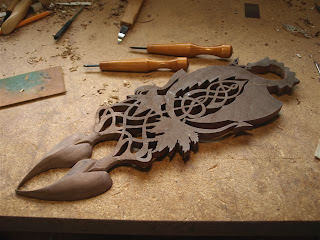 With the front of the Eisteddfod Spoon largely completed, it's time to focus some energy on the back. I'm a firm believer in making the back of the spoon as beautiful as the front...even if it is going to hang on a wall and only be viewed from one angle. It takes more time and effort and increases the chances of a break or accident, BUT the result is always a much more beautiful and tactile piece. Sometimes, as a professional carver, my client's budgets don't stretch to doing both sides and they wish me to concentrate my efforts on the front only. Even in those cases, I like to try to do some shaping of the back to lend the spoon a bit more elegance.
With the front of the Eisteddfod Spoon largely completed, it's time to focus some energy on the back. I'm a firm believer in making the back of the spoon as beautiful as the front...even if it is going to hang on a wall and only be viewed from one angle. It takes more time and effort and increases the chances of a break or accident, BUT the result is always a much more beautiful and tactile piece. Sometimes, as a professional carver, my client's budgets don't stretch to doing both sides and they wish me to concentrate my efforts on the front only. Even in those cases, I like to try to do some shaping of the back to lend the spoon a bit more elegance.
As you can see from this close-up, the back is currently pretty flat and monotonous, even though the majority of the design outline is clearly visible and the spoon is 'coming to life'. By shaping up the back, I'll not only get a more beautiful product when the spoon is handled and turned over, but the shadows cast by the undulations and curves I plan to create will give the spoon more 'life' and appeal when it hangs on the wall. Lovespoons are an artwork which begs to be handled. Unlike some arts which can be discoloured and marred by the oils of the hand, the lovespoon inevitably profits from regular handling. Over the course of many years, a rich patina builds up and the spoon takes on a lovely vibrant glow which is impossible to replicate solely with the finishes. In this modern age of half-assed manufacturing, where virtually everything we get has had corners cut somewhere or other, it is always a lovely surprise to find the back of the spoon as nicely finished as the front.
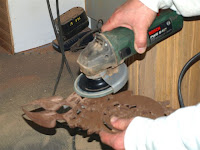 But before you go thinking I'm getting all arty-farty and precious about this, I can assure you that doing the back of the spoon also often gives me the opportunity to break out the beloved angle grinder! I LOVE to make all kinds of noise and dust every once in a while and the angle grinder is great for both! Although I spend most of my carving time serenaded by the eloquent strains of Mozart from the cd player and alone in contemplative thought...the high pitched scream of a wound-up grinder hogging its way along can be music to my headphone covered ears!! But a warning: Kids, do NOT try this at home or anywhere else until you have lots of experience! The grinder is a great tool for removing awkward wood in a great hurry, but it is equally good at destroying your project and quite possibly removing your fingers or whole hand. This is NOT a tool to handle lightly. For me, it is a highly efficient time saving wonder, but sometimes it is an extremely fickle mistress. On this spoon it will help me put some arc and curve into the wood and it will deal with some tangled grain sections; hopefully it will do this without blowing the whole project to smithereens!
But before you go thinking I'm getting all arty-farty and precious about this, I can assure you that doing the back of the spoon also often gives me the opportunity to break out the beloved angle grinder! I LOVE to make all kinds of noise and dust every once in a while and the angle grinder is great for both! Although I spend most of my carving time serenaded by the eloquent strains of Mozart from the cd player and alone in contemplative thought...the high pitched scream of a wound-up grinder hogging its way along can be music to my headphone covered ears!! But a warning: Kids, do NOT try this at home or anywhere else until you have lots of experience! The grinder is a great tool for removing awkward wood in a great hurry, but it is equally good at destroying your project and quite possibly removing your fingers or whole hand. This is NOT a tool to handle lightly. For me, it is a highly efficient time saving wonder, but sometimes it is an extremely fickle mistress. On this spoon it will help me put some arc and curve into the wood and it will deal with some tangled grain sections; hopefully it will do this without blowing the whole project to smithereens!
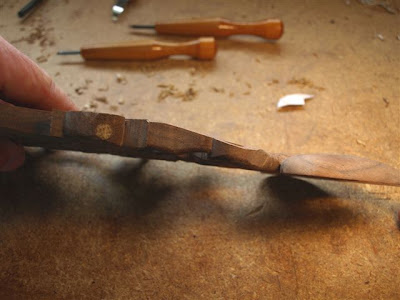 As the wood is shaped, the spoon will become both physically and visually lighter and the final look will start to emerge. Here's a little close-up of what the angle grinder can quickly achieve. More next week as we start shaping the vines and finishing off the already shaped bowl backs.
As the wood is shaped, the spoon will become both physically and visually lighter and the final look will start to emerge. Here's a little close-up of what the angle grinder can quickly achieve. More next week as we start shaping the vines and finishing off the already shaped bowl backs.
If you haven't yet contributed to the Eisteddfod, please consider doing so today! You can win this spoon!!
Left Coast Eisteddfod Now Extending to Second Day! Line up for Friday Night Show Now Finalised!
By Ceri Shaw, 2009-04-08
The Left Coast Eisteddfod in Portland Oregon is being extended to a second day. The event will now run from Fri 21st August to Sat 22nd August. A concert on Friday night will feature Here Be Dragons , Jesus Presley and Runaway Norm . Read our interview with Mike Brooks of Here Be Dragons HERE . The full schedule for both the Friday and Saturday programs will be available and linked shortly from the Left Coast Eisteddfod page and downloadable in PDF format. Watch this space for more exciting announcements!
We are also pleased to announce that Welsh author Chris Keil will be attending the event along with Niall Griffiths and Penny Simpson . Chris is the author of two novels:- "The French Thing" and "Liminal". See our interview with Chris here .
All three will be giving a series of readings both at the Eisteddfod and at the Central Library amongst other venues. Here is the Library Event page on Americymru:- Welsh Month at Portland Library. If you are an Americymru member and planning to attend please RSVP on the event page. The Library event is free and, of course, open to non-Americymru members.
Alcemi Write Up on The Left Coast Eisteddfod.
Read the Alcemi write-up on The Left Coast eisteddfod here . Alcemi is a leading Welsh publishing house and a key sponsor of the Left Coast eisteddfod.
HERE BE DRAGONS - I'M NOT DRUNK
JESUS PRESLEY - LATE NIGHT BOOTY CALL
We are Home
We have all arrived safely home. A 11 hour wait for a delayed flight in Orlando airport and with security taking our bike bags apart and swabbing everything, left the team totally exhausted.
We have our party on Thursday in the Botanical Gardens of Wales. Hope to see you there. it's a 1830 hrs start in the Great Glass House
Please check back to see the updates on the blog.
Thank you everyone - your support has been overwhelming and without it, the C2C challenge would not have maintained the high morale that was needed to complete the crossing of the continent.

